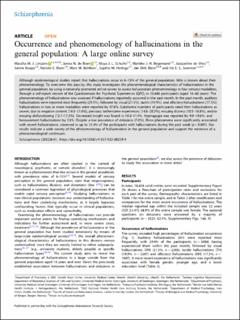| dc.description.abstract | Although epidemiological studies report that hallucinations occur in 6–15% of the general population, little is known about their phenomenology. To overcome this paucity, this study investigates the phenomenological characteristics of hallucinations in the general population, by using a nationally promoted online survey to assess hallucination phenomenology in four sensory modalities, through a self-report version of the Questionnaire for Psychotic Experiences (QPE), in 10,448 participants (aged 14–88 years). The phenomenology of hallucinations was assessed if hallucinations reportedly occurred in the past month. In the past month, auditory hallucinations were reported most frequently (29.5%), followed by visual (21.5%), tactile (19.9%), and olfactory hallucinations (17.3%); hallucinations in two or more modalities were reported by 47.6%. Substantial numbers of participants rated their hallucinations as severe, due to negative content (16.0–31.6%), previous bothersome experiences (14.8–20.2%), ensuing distress (10.5–16.8%), and/or ensuing disfunctioning (12.7–17.3%). Decreased insight was found in 10.2–11.4%. Hypnagogia was reported by 9.0–10.6%, and bereavement hallucinations by 2.8%. Despite a low prevalence of delusions (7.0%), these phenomena were significantly associated with recent hallucinations, observed in up to 13.4% of the participants with hallucinations during the past week (p < 0.001). Our results indicate a wide variety of the phenomenology of hallucinations in the general population and support the existence of a phenomenological continuum. | en_US |

